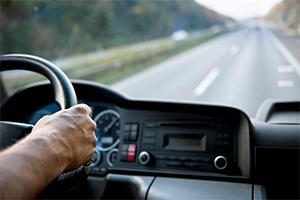Distracted driving
A government study concluded that driver distraction or inattention is a factor in over 70 percent of accidents. Drivers are two times more likely to be involved in a crash or near crash when talking on a cell phone, and three times more likely when dialing or operating a cell phone or electronic device.
Applying makeup or reading while driving increases the chance of a crash by three times. Inserting a CD doubles the likelihood of an accident. Eating while driving increases odds of an accident by one and a half times. Reaching for a moving object while driving increases chances of an accident by a whopping nine times, according to the National Highway Traffic Safety Administration study.
The study found that taking your eyes off the road for more than two seconds significantly increases chances of an accident. Drowsy drivers are four to six times more likely to be involved in a crash or near crash than drivers who are attentive.
Common driver distractions
- Cell phones and navigation systems: dialing, entering addresses
- Eating food or drinking a beverage
- Talking and listening to other passengers in the vehicle
- Radio use: changing stations, CDs, etc.
- Smoking: lighting up, putting out, falling ashes
- Looking at billboards, scenic views, searching for an address
- Daydreaming: problems at home, relationships, etc.
- Attending to children or pets
Things to do before driving
- Get plenty of rest before getting behind the wheel
- Take care of grooming (makeup, hair, shaving, flossing, nails, contacts, etc.)
- Be familiar with your vehicle’s controls
- Adjust mirrors, seat and radio
- Safely secure children and pets; stow any loose objects
- Place sun glasses, toll money, etc. within reach
When operating a vehicle
- Drive defensively and always wear your seatbelt
- Do not use electronic devices except in an emergency
- Do not read or write anything
- Do not eat or drink, and avoid smoking
- Do not engage in distracting conversations
- Do not pick up or reach for a dropped or loose object
- Pay attention to the road ahead, stay focused and expect the unexpected
- If you feel tired park in a safe place and take a break
Source: U.S. Dept. of Transportation report “The Impact of Driver Inattention On Near-Crash/Crash Risk” April 2006
This material is provided for informational purposes only and does not provide any coverage or guarantee loss prevention. The examples in this material are provided as hypothetical and for illustration purposes only. The Hanover Insurance Company and its affiliates and subsidiaries (“The Hanover”) specifically disclaim any warranty or representation that acceptance of any recommendations contained herein will make any premises, or operation safe or in compliance with any law or regulation. By providing this information to you, The Hanover does not assume (and specifically disclaims) any duty, undertaking or responsibility to you. The decision to accept or implement any recommendation(s) or advice contained in this material must be made by you.
LC APR 2019 08-71
171-1002 (1/14)
Related resources
Distracted driving
A government study concluded that driver distraction or inattention is a factor in over 70 percent of accidents. Drivers are two times more likely to be involved in a crash or near crash when talking on a cell phone, and three times more likely when dialing or operating a cell phone or electronic device.
Applying makeup or reading while driving increases the chance of a crash by three times. Inserting a CD doubles the likelihood of an accident. Eating while driving increases odds of an accident by one and a half times. Reaching for a moving object while driving increases chances of an accident by a whopping nine times, according to the National Highway Traffic Safety Administration study.
The study found that taking your eyes off the road for more than two seconds significantly increases chances of an accident. Drowsy drivers are four to six times more likely to be involved in a crash or near crash than drivers who are attentive.
Common driver distractions
- Cell phones and navigation systems: dialing, entering addresses
- Eating food or drinking a beverage
- Talking and listening to other passengers in the vehicle
- Radio use: changing stations, CDs, etc.
- Smoking: lighting up, putting out, falling ashes
- Looking at billboards, scenic views, searching for an address
- Daydreaming: problems at home, relationships, etc.
- Attending to children or pets
Things to do before driving
- Get plenty of rest before getting behind the wheel
- Take care of grooming (makeup, hair, shaving, flossing, nails, contacts, etc.)
- Be familiar with your vehicle’s controls
- Adjust mirrors, seat and radio
- Safely secure children and pets; stow any loose objects
- Place sun glasses, toll money, etc. within reach
When operating a vehicle
- Drive defensively and always wear your seatbelt
- Do not use electronic devices except in an emergency
- Do not read or write anything
- Do not eat or drink, and avoid smoking
- Do not engage in distracting conversations
- Do not pick up or reach for a dropped or loose object
- Pay attention to the road ahead, stay focused and expect the unexpected
- If you feel tired park in a safe place and take a break
Source: U.S. Dept. of Transportation report “The Impact of Driver Inattention On Near-Crash/Crash Risk” April 2006
This material is provided for informational purposes only and does not provide any coverage or guarantee loss prevention. The examples in this material are provided as hypothetical and for illustration purposes only. The Hanover Insurance Company and its affiliates and subsidiaries (“The Hanover”) specifically disclaim any warranty or representation that acceptance of any recommendations contained herein will make any premises, or operation safe or in compliance with any law or regulation. By providing this information to you, The Hanover does not assume (and specifically disclaims) any duty, undertaking or responsibility to you. The decision to accept or implement any recommendation(s) or advice contained in this material must be made by you.
LC APR 2019 08-71
171-1002 (1/14)
Related resources
Distracted driving
A government study concluded that driver distraction or inattention is a factor in over 70 percent of accidents. Drivers are two times more likely to be involved in a crash or near crash when talking on a cell phone, and three times more likely when dialing or operating a cell phone or electronic device.
Applying makeup or reading while driving increases the chance of a crash by three times. Inserting a CD doubles the likelihood of an accident. Eating while driving increases odds of an accident by one and a half times. Reaching for a moving object while driving increases chances of an accident by a whopping nine times, according to the National Highway Traffic Safety Administration study.
The study found that taking your eyes off the road for more than two seconds significantly increases chances of an accident. Drowsy drivers are four to six times more likely to be involved in a crash or near crash than drivers who are attentive.
Common driver distractions
- Cell phones and navigation systems: dialing, entering addresses
- Eating food or drinking a beverage
- Talking and listening to other passengers in the vehicle
- Radio use: changing stations, CDs, etc.
- Smoking: lighting up, putting out, falling ashes
- Looking at billboards, scenic views, searching for an address
- Daydreaming: problems at home, relationships, etc.
- Attending to children or pets
Things to do before driving
- Get plenty of rest before getting behind the wheel
- Take care of grooming (makeup, hair, shaving, flossing, nails, contacts, etc.)
- Be familiar with your vehicle’s controls
- Adjust mirrors, seat and radio
- Safely secure children and pets; stow any loose objects
- Place sun glasses, toll money, etc. within reach
When operating a vehicle
- Drive defensively and always wear your seatbelt
- Do not use electronic devices except in an emergency
- Do not read or write anything
- Do not eat or drink, and avoid smoking
- Do not engage in distracting conversations
- Do not pick up or reach for a dropped or loose object
- Pay attention to the road ahead, stay focused and expect the unexpected
- If you feel tired park in a safe place and take a break
Source: U.S. Dept. of Transportation report “The Impact of Driver Inattention On Near-Crash/Crash Risk” April 2006
This material is provided for informational purposes only and does not provide any coverage or guarantee loss prevention. The examples in this material are provided as hypothetical and for illustration purposes only. The Hanover Insurance Company and its affiliates and subsidiaries (“The Hanover”) specifically disclaim any warranty or representation that acceptance of any recommendations contained herein will make any premises, or operation safe or in compliance with any law or regulation. By providing this information to you, The Hanover does not assume (and specifically disclaims) any duty, undertaking or responsibility to you. The decision to accept or implement any recommendation(s) or advice contained in this material must be made by you.
LC APR 2019 08-71
171-1002 (1/14)
Related resources
Distracted driving
A government study concluded that driver distraction or inattention is a factor in over 70 percent of accidents. Drivers are two times more likely to be involved in a crash or near crash when talking on a cell phone, and three times more likely when dialing or operating a cell phone or electronic device.
Applying makeup or reading while driving increases the chance of a crash by three times. Inserting a CD doubles the likelihood of an accident. Eating while driving increases odds of an accident by one and a half times. Reaching for a moving object while driving increases chances of an accident by a whopping nine times, according to the National Highway Traffic Safety Administration study.
The study found that taking your eyes off the road for more than two seconds significantly increases chances of an accident. Drowsy drivers are four to six times more likely to be involved in a crash or near crash than drivers who are attentive.
Common driver distractions
- Cell phones and navigation systems: dialing, entering addresses
- Eating food or drinking a beverage
- Talking and listening to other passengers in the vehicle
- Radio use: changing stations, CDs, etc.
- Smoking: lighting up, putting out, falling ashes
- Looking at billboards, scenic views, searching for an address
- Daydreaming: problems at home, relationships, etc.
- Attending to children or pets
Things to do before driving
- Get plenty of rest before getting behind the wheel
- Take care of grooming (makeup, hair, shaving, flossing, nails, contacts, etc.)
- Be familiar with your vehicle’s controls
- Adjust mirrors, seat and radio
- Safely secure children and pets; stow any loose objects
- Place sun glasses, toll money, etc. within reach
When operating a vehicle
- Drive defensively and always wear your seatbelt
- Do not use electronic devices except in an emergency
- Do not read or write anything
- Do not eat or drink, and avoid smoking
- Do not engage in distracting conversations
- Do not pick up or reach for a dropped or loose object
- Pay attention to the road ahead, stay focused and expect the unexpected
- If you feel tired park in a safe place and take a break
Source: U.S. Dept. of Transportation report “The Impact of Driver Inattention On Near-Crash/Crash Risk” April 2006
This material is provided for informational purposes only and does not provide any coverage or guarantee loss prevention. The examples in this material are provided as hypothetical and for illustration purposes only. The Hanover Insurance Company and its affiliates and subsidiaries (“The Hanover”) specifically disclaim any warranty or representation that acceptance of any recommendations contained herein will make any premises, or operation safe or in compliance with any law or regulation. By providing this information to you, The Hanover does not assume (and specifically disclaims) any duty, undertaking or responsibility to you. The decision to accept or implement any recommendation(s) or advice contained in this material must be made by you.
LC APR 2019 08-71
171-1002 (1/14)





